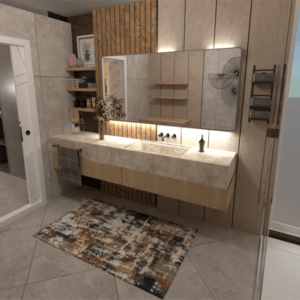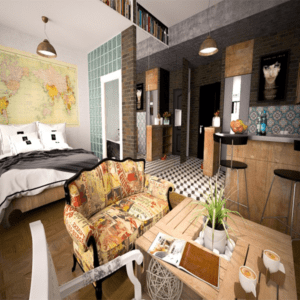Are you passionate about creating aesthetically pleasing and functional spaces? Do you have an eye for detail and a knack for creativity? If so, a career in interior design might be the perfect fit for you. In today’s article, we will provide you with comprehensive information about our diploma in interior designing program in Noida. By the end of this article, you will have a clear understanding of the course, the benefits it offers, and how it can help you kickstart a successful career in the field of interior design.
Introduction:
Interior design is the art and science of creating functional and aesthetically pleasing spaces within buildings. It involves designing the interior layout, selecting appropriate colours, materials, and furnishings, and ensuring that the space reflects the client’s needs and preferences. In this blog post, we will delve into the fascinating world of interior design, exploring its principles, process, and various elements that come together to transform a space into a harmonious and captivating environment.
Understanding the Principles of Interior Design:
The interior design follows several key principles that guide designers in creating appealing and functional spaces. These principles include balance, proportion, unity, rhythm, emphasis, and scale. We will explore each of these principles in detail and provide practical examples of how they can be applied to achieve a cohesive and visually pleasing design.
The Interior Design Process:
Interior design is a multi-step process that encompasses various stages, from initial concept development to final implementation. We will outline the typical steps involved, including client consultation, space planning, conceptualization, material selection, and project management. Understanding the design process will help readers gain insight into the systematic approach employed by interior designers.
Space Planning and Layout:
One of the fundamental aspects of interior design is space planning. Efficiently organizing the available space involves determining the optimal placement of furniture, fixtures, and other elements. We will discuss the importance of functionality, traffic flow, and ergonomics in space planning, providing practical tips for maximizing the use of space while maintaining an appealing aesthetic.
Colours and Materials:
Colour selection plays a crucial role in interior design, as different colours evoke different moods and emotions. We will explore the psychological impact of various colours and delve into colour schemes and combinations that can create specific atmospheres within a space. Additionally, we will discuss the selection of materials, such as flooring, wall coverings, and fabrics, highlighting their influence on the overall design concept.
Lighting Design:
Lighting is an essential element in interior design, as it affects both the functionality and ambiance of a space. We will delve into the different types of lighting, including natural, ambient, task, and accent lighting, and explain how each can be used to enhance various areas within a room. Moreover, we will explore lighting fixtures, techniques, and the role of lighting in creating focal points and highlighting architectural features.
Furniture and Accessories:
Furniture and accessories add character and style to an interior space. We will discuss the selection of furniture pieces, considering factors such as comfort, scale, and style. Additionally, we will explore the use of accessories, such as artwork, rugs, curtains, and decorative items, to personalize and enhance the overall design.
Sustainable and Eco-Friendly Design:
With a growing emphasis on sustainability and environmental consciousness, interior design has embraced eco-friendly practices. We will explore the concept of sustainable design and discuss strategies for incorporating energy-efficient systems, eco-friendly materials, and environmentally conscious practices into interior design projects.
Understanding Interior Design Principles
1. Balance and Proportion
Achieving balance and proportion is crucial in interior design. It involves distributing visual weight evenly across space to create a sense of equilibrium. Whether through symmetrical or asymmetrical arrangements, balance brings a pleasing harmony to the eye.
2. Harmony and Unity
Harmony and unity in design ensure that all elements work together cohesively. By selecting complementary colours, textures, and patterns, designers can establish a sense of continuity and unity throughout the space.
3. Emphasis and Focal Points
Emphasis helps create focal points that draw attention and guide the viewer’s gaze. These focal points can be achieved through the strategic placement of artwork, furniture, or architectural features.
4. Rhythm and Movement
Rhythm and movement contribute to the flow and energy within a space. Repetition of shapes, patterns, or colors can establish a sense of rhythm, while the arrangement of furniture and spatial layout can create a natural flow.
5. Essential Elements of Interior Design
- Colour Palette and Mood
Choosing the right colour palette sets the tone for a space. Warm colours can create a cozy atmosphere, while cool colours evoke a sense of calm. Understanding colour psychology helps create the desired mood.
- Lighting and Ambiance
Lighting plays a crucial role in interior design. A well-lit space can enhance the mood and highlight key features. Utilizing a combination of natural and artificial lighting sources can create a dynamic and inviting ambiance.
- Furniture and Layout
Selecting appropriate furniture and arranging it strategically is essential for a functional and visually appealing space. Consider the scale, proportion, and functionality of each piece, ensuring they harmonize with the overall design.
- Textures and Materials
Textures and materials add depth and visual interest to an interior. Incorporating a mix of smooth, rough, soft, and tactile elements can create a sensory experience that enhances the overall design.
- Accessories and Decor
Accessories and decor provide the finishing touches that personalize a space. Thoughtfully chosen artwork, rugs, cushions, and other accessories can add character and reflect the occupants’ personality and style.
Interior Design Styles Explored at The International Academy of Designs and Arts (IADA)

Let’s explore some popular interior design styles that you can learn about and master during your time at our esteemed institute in Noida.
- Contemporary Design
Contemporary design, taught at IADA, embraces the present and future, focusing on clean lines, minimalism, and functionality. Students learn to create spaces that feature neutral colour palettes, sleek furniture, and open layouts to promote an airy and spacious feel.
- Minimalist Design
Minimalism is a design style that emphasizes simplicity and removes unnecessary clutter. At IADA, you’ll delve into the principles of minimalist design, learning how to create serene and uncluttered spaces. By embracing clean lines, a limited colour palette, and the principle of “less is more,” you’ll be able to design interiors that exude a sense of calm and sophistication.
- Traditional Design
Drawing inspiration from classic aesthetics, traditional design embodies elegance and timelessness. At IADA, you’ll have the opportunity to explore the intricacies of traditional design, understanding how to incorporate ornate details, rich colours, and luxurious materials.
- Industrial Design
Industrial design takes cues from the raw and unfinished elements found in old factories and warehouses. At IADA, you’ll learn how to showcase exposed brick, metal, and concrete, creating spaces that blend modern and vintage elements. With a focus on open spaces, high ceilings, and unique furnishings, industrial design allows you to create visually captivating interiors that embrace the beauty of urban aesthetics.
- Scandinavian Design
The Scandinavian design focuses on simplicity, functionality, and a deep connection to nature. At IADA, you’ll explore the principles of Scandinavian design, emphasizing natural light, minimalism, clean lines, and a neutral colour palette.
Essential Elements of Interior Design Taught at IADA
During your diploma program at IADA, you’ll gain in-depth knowledge of the essential elements that form the foundation of interior design. These elements will shape your understanding of creating captivating and functional spaces. Let’s take a look at some of these crucial elements:
- Colour Palette and Mood
Choosing the right colour palette is key to setting the tone and mood of a space. At IADA, you’ll learn how different colours evoke specific emotions and create desired atmospheres. Whether it’s selecting warm colours for a cozy ambience or cool colours for a calming effect, understanding colour psychology will enable you to create impactful and harmonious interiors.
- Lighting and Ambiance
Lighting plays a significant role in interior design, and at IADA, you’ll learn how to master its art. Through our program, you’ll discover how lighting can enhance the mood and highlight key features in a space. You’ll gain insights into utilizing a combination of natural and artificial lighting sources to create dynamic and inviting ambiences that transform the look and feel of a room.
- Furniture and Layout
Selecting appropriate furniture pieces and arranging them strategically is crucial for creating functional and visually appealing spaces. At IADA, you’ll understand the principles of furniture selection, considering scale, proportion, and functionality. You’ll learn how to harmonize furniture with the overall design scheme, ensuring that each piece serves a purpose while contributing to the overall aesthetic appeal.
- Textures and Materials
Textures and materials add depth, visual interest, and tactile experiences to interiors. At IADA, you’ll explore a wide range of materials, from smooth to rough, soft to hard, and understand how to incorporate them effectively. By learning the art of combining different textures, you’ll create multi-dimensional spaces that engage the senses and elevate the overall design.
- Accessories and Decor
Accessories and decor are the finishing touches that add personality and character to a space. At IADA, you’ll explore the world of accessories, such as artwork, rugs, cushions, and other decorative elements. You’ll learn how to curate and style these items to enhance the overall design concept and reflect the occupants’ unique style and preferences.
Exploring Exciting Career Opportunities after Completing the Interior Design Diploma Program at IADA

Completing the interior design diploma program at The International Academy of Designs and Arts (IADA) opens up a wide range of career opportunities in the field of interior design. With a solid foundation in design principles, practical skills, and industry knowledge, you’ll be well-prepared to pursue various career paths. Some potential career opportunities include:
Interior Designer: As an interior designer, you can work independently or as part of a design firm, creating innovative and functional interiors for residential, commercial, or hospitality projects. You’ll collaborate with clients, understand their requirements, and translate them into visually stunning and practical designs.
Interior Decorator: If you have a passion for styling and creating beautiful spaces, a career as an interior decorator might be ideal for you. As an interior decorator, you’ll focus on selecting and arranging furniture, accessories, and decorative elements to enhance the aesthetic appeal of a space.
Design Consultant: With your expertise in interior design, you can offer consulting services to clients, providing them with valuable advice and guidance on design concepts, space planning, colour schemes, and more. Design consultants often work on a freelance basis or as part of design agencies.
Set Designer: Set designers are responsible for creating captivating and functional sets for film, television, theatre, and other entertainment productions. With your interior design skills, you can bring stories to life by designing sets that reflect the desired time period, atmosphere, and mood.
Exhibition Designer: Exhibition designers specialize in creating engaging and immersive exhibition spaces for museums, galleries, trade shows, and events. You’ll have the opportunity to showcase art, products, or information through innovative and visually appealing design concepts.
Retail Store Designer: Retail store designers focus on creating attractive and functional retail environments that enhance the customer experience. You’ll work closely with store owners to design layouts, displays, and fixtures that promote brand identity and drive sales.
Furniture Designer: If you have a passion for furniture design, you can pursue a career as a furniture designer. You’ll create unique and innovative furniture pieces that blend aesthetics, functionality, and comfort.
These are just a few examples of the many career opportunities available in the field of interior design after completing the diploma program at IADA. The industry offers a diverse range of possibilities, allowing you to specialize in areas that align with your interests and talents. Additionally, IADA provides career counselling and job placement assistance to help students explore and seize employment opportunities in the industry.
Embark on your journey towards a fulfilling career in interior design by enrolling in the interior design diploma program at IADA. Gain the knowledge, skills, and confidence to make your mark in the dynamic world of interior design.
For those seeking a comprehensive education in interior design and the opportunity to explore these styles and elements in-depth, The International Academy of Designs and Arts (IADA) is your ideal choice. With our experienced faculty, industry-relevant curriculum, and state-of-the-art facilities, we provide a nurturing environment for aspiring designers to thrive and develop their creative abilities.
Unlock your potential and embark on a rewarding journey in the world of interior design by joining diploma in interior design at IADA today!



